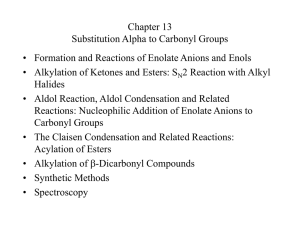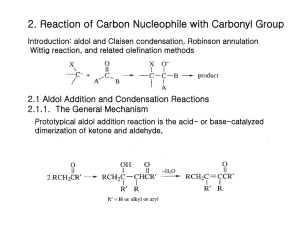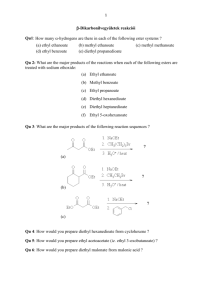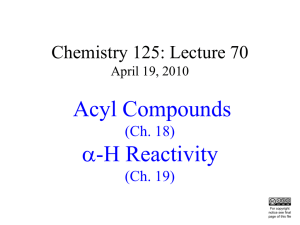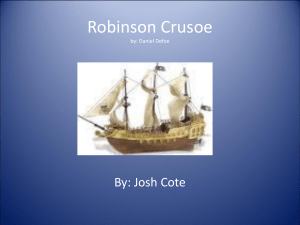File - Bethany College Portfolio
advertisement
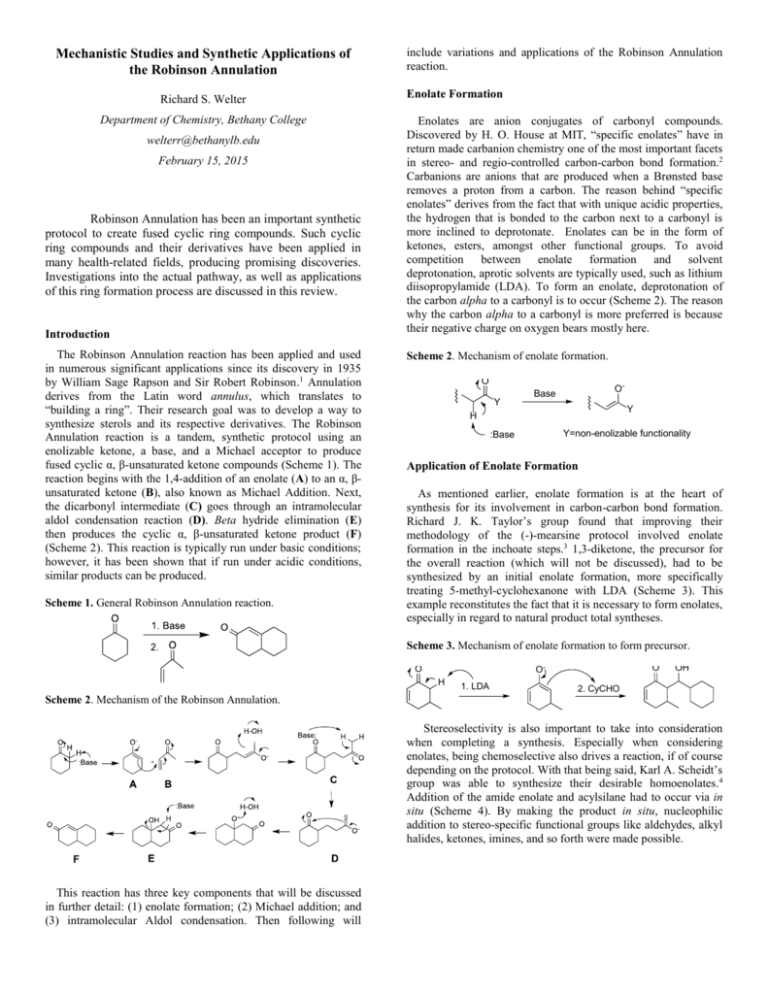
Mechanistic Studies and Synthetic Applications of the Robinson Annulation Richard S. Welter Department of Chemistry, Bethany College welterr@bethanylb.edu February 15, 2015 Robinson Annulation has been an important synthetic protocol to create fused cyclic ring compounds. Such cyclic ring compounds and their derivatives have been applied in many health-related fields, producing promising discoveries. Investigations into the actual pathway, as well as applications of this ring formation process are discussed in this review. Introduction The Robinson Annulation reaction has been applied and used in numerous significant applications since its discovery in 1935 by William Sage Rapson and Sir Robert Robinson.1 Annulation derives from the Latin word annulus, which translates to “building a ring”. Their research goal was to develop a way to synthesize sterols and its respective derivatives. The Robinson Annulation reaction is a tandem, synthetic protocol using an enolizable ketone, a base, and a Michael acceptor to produce fused cyclic α, β-unsaturated ketone compounds (Scheme 1). The reaction begins with the 1,4-addition of an enolate (A) to an α, βunsaturated ketone (B), also known as Michael Addition. Next, the dicarbonyl intermediate (C) goes through an intramolecular aldol condensation reaction (D). Beta hydride elimination (E) then produces the cyclic α, β-unsaturated ketone product (F) (Scheme 2). This reaction is typically run under basic conditions; however, it has been shown that if run under acidic conditions, similar products can be produced. Scheme 1. General Robinson Annulation reaction. include variations and applications of the Robinson Annulation reaction. Enolate Formation Enolates are anion conjugates of carbonyl compounds. Discovered by H. O. House at MIT, “specific enolates” have in return made carbanion chemistry one of the most important facets in stereo- and regio-controlled carbon-carbon bond formation.2 Carbanions are anions that are produced when a Brønsted base removes a proton from a carbon. The reason behind “specific enolates” derives from the fact that with unique acidic properties, the hydrogen that is bonded to the carbon next to a carbonyl is more inclined to deprotonate. Enolates can be in the form of ketones, esters, amongst other functional groups. To avoid competition between enolate formation and solvent deprotonation, aprotic solvents are typically used, such as lithium diisopropylamide (LDA). To form an enolate, deprotonation of the carbon alpha to a carbonyl is to occur (Scheme 2). The reason why the carbon alpha to a carbonyl is more preferred is because their negative charge on oxygen bears mostly here. Scheme 2. Mechanism of enolate formation. O Y O- Base Y H Y=non-enolizable functionality :Base Application of Enolate Formation As mentioned earlier, enolate formation is at the heart of synthesis for its involvement in carbon-carbon bond formation. Richard J. K. Taylor’s group found that improving their methodology of the (-)-mearsine protocol involved enolate formation in the inchoate steps.3 1,3-diketone, the precursor for the overall reaction (which will not be discussed), had to be synthesized by an initial enolate formation, more specifically treating 5-methyl-cyclohexanone with LDA (Scheme 3). This example reconstitutes the fact that it is necessary to form enolates, especially in regard to natural product total syntheses. Scheme 3. Mechanism of enolate formation to form precursor. O O- O H 1. LDA OH 2. CyCHO Scheme 2. Mechanism of the Robinson Annulation. Stereoselectivity is also important to take into consideration when completing a synthesis. Especially when considering enolates, being chemoselective also drives a reaction, if of course depending on the protocol. With that being said, Karl A. Scheidt’s group was able to synthesize their desirable homoenolates. 4 Addition of the amide enolate and acylsilane had to occur via in situ (Scheme 4). By making the product in situ, nucleophilic addition to stereo-specific functional groups like aldehydes, alkyl halides, ketones, imines, and so forth were made possible. This reaction has three key components that will be discussed in further detail: (1) enolate formation; (2) Michael addition; and (3) intramolecular Aldol condensation. Then following will Scheme 7. Generalized Michael Addition of nitroalkene. Scheme 4. Generalized homoenolate formation. O Me 2N O 1. LDA 2. Me 2N Ar OTMS O Ar Ar Me 2N OH E O R' H + R O Me 3Si O Y R' O N H O 1. Base 2. Y R R Y=non-enolizable functionality R= unsaturated withdrawing group Scheme 6. Mechanism of Michael Addition O OY Ph Ph Aldol Condensation Aldol Condensation is an organic reaction in which an enolate ion and a base react to an electrophilic carbonyl (Scheme 6). Aldol derives from combining the terms aldehyde and alcohol. This particular reaction has been renown for its contribution towards forming incredible carbon-carbon bond products. This protocol calls for bases such as sodium ethoxide; however, acids have also been used to create aldols. The reaction begins with the base deprotonating the alpha carbon of the aldehyde to form an enolate (K). Next, the nucleophilic attack of the enolate ion on an electrophilic carbonyl (L) will form an intermediate alcohol (M). To successfully complete the reaction, the compound undergoes condensation to eliminate the alcohol to form the finishing aldol product (N) (Scheme 7). Take note that aldol products are α, βunsaturated, thus also being Michael acceptors for further synthetic investigation. It is also important to note that if following the condensation step results in a dicarbonyl intermediate (D), the enolate component and the carbonyl component will intramolecularly condense to form a cyclic compound. For most cases, 5, 6, and/or 7-membered rings are favored. Scheme 6. General Aldol Condensation reaction. G H :Base (2) O N + Y H R NO 2 OH Michael Addition Scheme 5. General Michael Addition reaction. R H Catalyst: Ar = aromoatic ring E = Bn-Br, allyl-Br, alkyl-I, PhCHO, Me 2CO Michael Addition is the nucleophilic addition of an enolizable ketone to a α, β-unsaturated withdrawing group (Scheme 5), established by Arthur Michael.5 This is an important step for the overall Robinson Annulation mechanism. Michael Addition allows conjugation in the finishing cyclic product, indicating stability within the product. The reaction calls for the formation of the enolate ion. Typically, a base, such as sodium hydroxide or potassium hydroxide, are used to deprotonate the alpha carbon adjacent to the carbonyl. The newly formed enolate (G) then nucleophilically adds to the electrophilic Michael acceptor (H). Michael acceptors are α, β-unsaturated ketones, which favors the addition of the nucleophile to the β-position. The final step is protonation of the anionic lone pair (I) (Scheme 6). This reaction will create a thermodynamic favorable product (J). O Catalyst NO 2 O Base O O Y Y R R J I Scheme 7. Mechanism of the Aldol Condensation reaction. O- O O O- O OH H-OH + H H-Base O :Base K L Application of Michael Addition It has been evident that additions of Michael acceptors and nitroalkenes have been very cumbersome and incredibly difficult to master. Reasons include that Michael addition provides up to three adjacent stereogenic centers and the value of the nitro group as a precursor for further functionalization. With the assistance of an organocatalyst with a hydrogen-bond donor at the α-position to the pyrrolidine nitrogen atom, Scheme 7 was made possible. 6 Furthermore, it shows how vital diastereo- and enantiocontrol truly is. O- O N OH H M :Base Application of Aldol Condensation Hauser Annulation To make an effective synthesis protocol, many things have to be taken into consideration: the number of steps, what reagents to use, the cost of those reagents, how environmentally friendly the reagents are, purity of product, amongst others. Anxin Wu’s team was able to efficiently synthesize an α, β-unsaturated α-iodo ketone directly from an α, β-unsaturated ketone by selective iodination and incorporating a critical aldol condensation step (Scheme 8). More specifically, by using copper(II) oxide/iodine, their method resulted in a faster reaction time, used inexpensive reagents, and most importantly, produced a clean product. 7 Similar to the Robinson Annulation reaction, Hauser Annulation involves using a Michael acceptor (P); however, instead of undergoing an intramolecular aldol condensation step, this protocol calls for Dieckmann condensation, an intramolecular chemical reaction involving diesters (Q) and a base to synthetically form β-ketoesters. Finally, an elimination of the sulfonic group will form the α, β-unsaturated product (R), similarly to the product of the Robinson Annulation reaction (Scheme 10).9 Scheme 10. General Hauser Annulation reaction. O Scheme 8. General Aldol condensation to α, β-unsaturated ketone. O O + R O R' H Base R' R S OEt O I R R' R = Ar, vinyl R' = H, Me Although a Michael acceptor is used in the Robinson Annulation protocol, there are other ways to make a Michael acceptor. For instance, in presence of a ketone, a Mannich base— a β-amino-ketone—can form into a Michael acceptor. In addition, under neutral conditions, enamines—an unsaturated compound derived from the condensation of a ketone or aldehyde with a secondary amine—can also form into a Michael acceptor. These are some examples for the plethora of ways to synthetically create a Michael acceptor. Scheme 9. General Wichterle Reaction. O O R R O + O COR COR QO R OH Morphine A variant of the Robinson Annulation procedure, the Wichterle reaction calls for an olefin group (O) instead of a vinyl methyl ketone. Although it is not the traditional α, β-unsaturated ketone, the olefin group mimics the Michael acceptor since undesirable condensation is still employed (Scheme 9).8 CH3 OR P Figure 1. Structure of Cortisone. Wichterle Reaction Cl R ∆ After Sir Robert Robinson established the Robinson Annulation reaction, the reaction played an important role in the development of biology-applied synthesis. Cortisone (Figure 1) is a hormone that is released from the Adrenal gland in response to stress. When stress occurs, the hormone is released, causing the blood pressure to increase, preparing the body for fight or flight response. Cortisone is particularly relevant because chemically, the Robinson Annulation reaction is a key step that is used to complete the synthesis of cortisone from cholesterol.10 As discussed prior, Michael acceptors are typically α, βunsaturated ketones. Nevertheless, aldehydes and acid derivatives are also considered as Michael acceptors. Olefins with nitro, cyano, keto, and ester groups are all electron withdrawing groups, like α, β-unsaturated ketones. R R LDA + Cortisone Michael Acceptor CH2Cl Ar For chemists involved in total synthesis, another feature that is taken into consideration is how applicable the product truly is. The application of synthetic chemistry towards biology is fundamental. There are a plethora of compounds in the healthrelated field that can be synthetically produced. Such promising discoveries are at the backbone for not only in further research, but also potential cures of diseases. Since the discovery of the Robinson Annulation reaction, there have been several variances to produce similar cyclic α, βunsaturated ketone compounds. Robinson Annulation products have been shown to be precursors for even more advanced syntheses, including natural product protocols as well as successfully synthesizing steroid compounds, which will be discussed later. H S Application of the Robinson Annulation Reaction Variances of the Robinson Annulation Reaction O O R O CuO/I 2 Ar Cl CH3 O CH3 R To enhance more to how impactful synthetic chemistry is to health-related fields, another endeavor that was made possible using the Robinson Annulation reaction was through the synthesis of morphine.11 Morphine is essentially an opioid. The analgesic is used to help pain threshold by increasing the tolerance to said pain, and thereby decreasing perception of pain. Opioids are the world’s oldest drug, found in the resin on Papaver somniferum (opium poppy). In chemistry prospective, morphine consists of a benzylisoquinoline alkaloid backbone with two additional ring closures (Figure 2). Figure 2. Structure of Morphine. Conclusion In conclusion, synthesizing natural products has opened the door to not only future synthesis work, but also to learn how the body works. For example, it is evident that the body does not treat Vitamin C any differently than ascorbic acid when digested. In addition, there is a Michael acceptor present in Figure 1, indicating the potential to form cortisone derivatives with further synthesis. The Robinson Annulation reaction has many facets, and because of those facets, it is obvious that this protocol is renown not only in chemistry, but significant in the medical field. It is not to say this reaction is more preferred or favorable than other cyclic forming reactions, like Diels-Alder, but it is definitely a reaction that can be applied in many areas. Acknowledgements. I would like to thank Dr. Luke McCormick for his tremendous assistance to my understanding of cyclohexane ring formation. References (1) Rapson, W.S.; Robinson, R. J. Am. Chem. Soc., 1935, 307, 1285-1288. (2) House, J.O. J. Org. Chem., 1971, 36, 2361 (3) Cuthbertson, J.D.; Godfrey, A.A.; Taylor, R.J.K., Tetrahedron Letters. 2010, 52, 2024-2027. (4) Lettan, R.B.; Galliford, C.V.; Woodward, C.C.; Scheidt, K.A, J. Am. Chem. Soc., 2006, 128, 15566-15567. (5) Little, R.D.; Masjedizadeh, M.R.; Wallquist, O.; McLoughlin, J.I., Org. React., 47, 315-552. (6) Palomo, C.; Vera, S.; Mielgo, A.; Gómez-Bengoa, E., Angew. Chem. Int. Ed., 2006, 45, 5984-5987. (7) Yin, G.; Qin, J.; Gao, M.; Cao, L.; Wu, A., Synthesis, 2008, 3565-3568. (8) Kobayashi, M.; Matsumoto, T., Chem. Lett., 1973, 957. (9) Hauser, F.M.; Rhee, R.P., J. Org. Chem., 1978, 43, 178-180. (10) Acheson, R.M.; Robinson, R., J. Org. Chem., 1952, 1127. (11) Mulzer, J., Angew. Chem. Int. Ed., 1996, 35, 2830.
